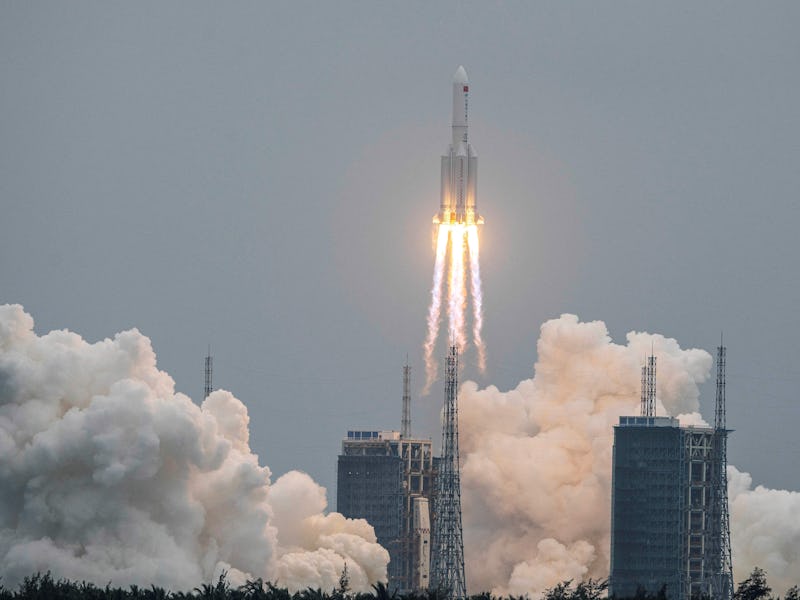Uncontrolled reentry: Why China “just not caring” is a huge problem for space
Debris from the Chinese rocket Long March 5B is about to hit Earth, and the space community is not happy about it.

Jonathan McDowell, an astrophysicist who tracks space debris when he’s not studying distant quasars, has been trying to determine why he’s so unhappy about China’s Long March 5B rocket.
“As a physicist, I like to quantify things,” McDowell tells Inverse.
The 22.5 metric ton Long March 5B is expected to make an uncontrolled reentry into Earth’s atmosphere within the next couple of days, with some of its debris possibly landing on inhabited areas. The incident will make it one of the largest spacecraft to reenter uncontrollably into the atmosphere, and it could have been avoided.
McDowell, of the Harvard-Smithsonian Center for Astrophysics, has drawn one big conclusion: “They’re deliberately just not caring and leaving it to reenter.”
As the space community anticipates the erratic and potentially destructive reentry of parts of the Chinese rocket into Earth’s atmosphere, some of its members are calling for stricter rules to regulate the manufacturing of rockets as more countries look to boost their space programs.
Here’s what happened — On Wednesday, the China National Space Administration (CNSA) launched the first module for its upcoming space station. The Long March 5B, a variant of China’s largest rocket, launched the Tianhe module from Wenchang, China. Here’s what you need to know:
- The Long March 5B is used for heavy-duty CNSA missions, such as interplanetary craft and large near-Earth payloads.
- The Long March 5B uses a core stage and four side boosters to place the space station modules into low-Earth orbit.
- Tianhe separated from the core stage of the launcher after 492 seconds of flight and entered its planned orbit.
- But the core stage remained in orbit, and is making an uncontrollable reentry into Earth’s atmosphere.
- The rocket’s core stage will be one of the largest pieces of space debris to make an uncontrolled reentry, with a possible risk of causing some damage on the ground.
This isn’t the first problematic reentry for CNSA. In 2017, the Tiangong-1 space station made an uncontrolled reentry, ultimately landing in the middle of the Pacific between Australia and Chile. In May 2020, another Long March 5B rocket made a chaotic reentry into Earth’s atmosphere, with some of it landing near the west coast of Africa. Pieces of the debris fell onto two villages in Cote d’Ivoire, causing damage to people’s businesses and homes.
A tweet shortly after the last uncontrolled re-entry
In this case, no one is quite sure — yet — where the rocket might re-enter. It could land into the ocean — but its erratic trajectory places it in the path of several populated areas, including New York, Madrid, parts of Chile, and parts of New Zealand, according to SpaceNews.
This could’ve been avoided — It didn’t have to be this way. Typically, rocket manufacturers account for the free-fall of rocket debris and make sure it doesn’t happen.
In order to avoid rockets falling over our heads, standard practice calls for one of two things, according to McDowell.
- The rocket stage is built with a booster to steer it into a safe landing point in the water after it reenters Earth’s atmosphere, or ...
- built with a rocket stage with some kind of stabilization system and a restartable engine whereby you can slow it down and turn it 180 degrees to land in the ocean.
China’s Long March 5B was not built with either of those options. “And so it's just left in orbit the old fashioned way to reenter uncontrolled and that is very unusual nowadays,” McDowell says.
Although there are no international regulations that stipulate rockets be built with this in mind, it is a best practice by space agencies around the world.
“When they did that design, they should have stopped and thought, ‘you know, that's going to leave a big chunk of debris in orbit, we should change the design of the engine’,” McDowell says. “But they didn't. This is real negligence.”
The Tianhe space station module during construction
Are there laws around space debris?
In January 1978, a nuclear-powered Soviet satellite accidentally re-entered Earth's atmosphere over northern Canada. Operation Morning Light was the clean-up effort that followed as rescuers searched for pieces of radioactive material in the tundra over the middle of Great Slave Lake.
“That was a particularly egregious case of letting something nasty reenter over someone else's country,” McDowell says.
The 1972 Convention on International Liability for Damage Caused by Space Objects holds the manufacturing agency accountable for whatever damage is caused by the falling space debris. Under the convention, the USSR made a payment of approximately $3,000,000 to the Canadian government.
But there are no specific rules on how to prevent space debris from falling over inhabited areas in the first place.
“I think there should be international agreements,” McDowell says. “And I don’t think we should expect more incidents like this one because most countries take this into account when they design a new rocket.”
The fact that China did not consider this in their rocket design reflects badly on the country’s space program, which has seen recent success after landing a rover on the Moon in November 2020 and preparing to land their first rover on Mars by May or June.
As more countries aim to boost their presence in space, McDowell expects there to be higher traffic in space. Mercifully, not all will result in these types of incidents whereby rocket debris falls uncontrollably on the ground.
“There'll be some increase in these accidents disproportionately and they will happen now and again but it shouldn't be a high rate,” McDowell says. “But if they keep launching these March 5Bs without changing the design, then that's a different story.”